Control Stock: Functions, Features, and Management Techniques
VerifiedAdded on 2023/06/18
|17
|3012
|314
AI Summary
This guide provides a comprehensive overview of control stock, including its functions, features, and management techniques. It covers topics such as perpetual inventory systems, imprest stock, electronic bin cards, stock control management, stock reorder cycles, and more. It also discusses how to monitor and adjust reorder cycles, record stock losses, and reduce theft. Additionally, it provides information on how to ensure continuity of supply and monitor delivery progress.
Contribute Materials
Your contribution can guide someone’s learning journey. Share your
documents today.

Control Stock
Secure Best Marks with AI Grader
Need help grading? Try our AI Grader for instant feedback on your assignments.
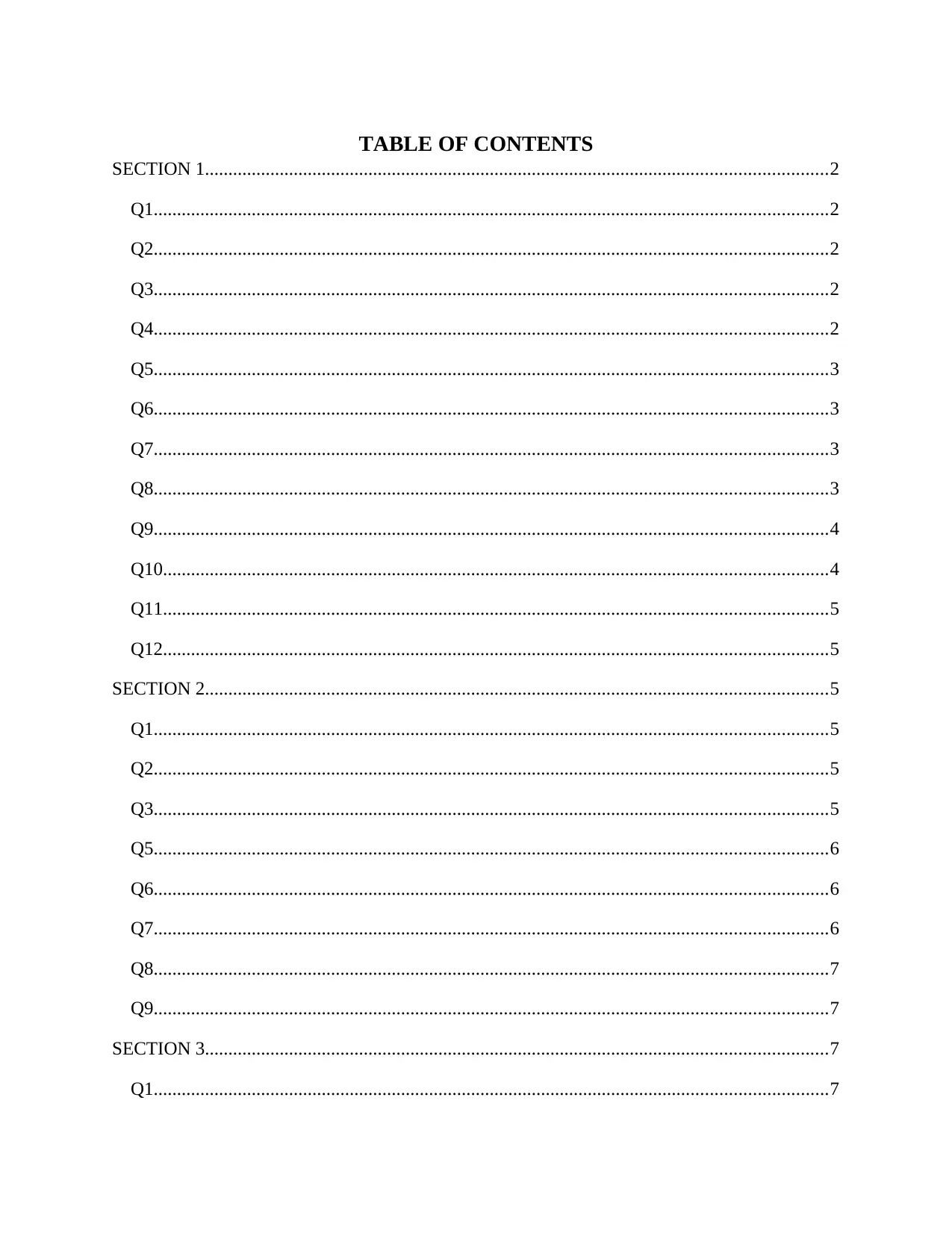
TABLE OF CONTENTS
SECTION 1.....................................................................................................................................2
Q1................................................................................................................................................2
Q2................................................................................................................................................2
Q3................................................................................................................................................2
Q4................................................................................................................................................2
Q5................................................................................................................................................3
Q6................................................................................................................................................3
Q7................................................................................................................................................3
Q8................................................................................................................................................3
Q9................................................................................................................................................4
Q10..............................................................................................................................................4
Q11..............................................................................................................................................5
Q12..............................................................................................................................................5
SECTION 2.....................................................................................................................................5
Q1................................................................................................................................................5
Q2................................................................................................................................................5
Q3................................................................................................................................................5
Q5................................................................................................................................................6
Q6................................................................................................................................................6
Q7................................................................................................................................................6
Q8................................................................................................................................................7
Q9................................................................................................................................................7
SECTION 3.....................................................................................................................................7
Q1................................................................................................................................................7
SECTION 1.....................................................................................................................................2
Q1................................................................................................................................................2
Q2................................................................................................................................................2
Q3................................................................................................................................................2
Q4................................................................................................................................................2
Q5................................................................................................................................................3
Q6................................................................................................................................................3
Q7................................................................................................................................................3
Q8................................................................................................................................................3
Q9................................................................................................................................................4
Q10..............................................................................................................................................4
Q11..............................................................................................................................................5
Q12..............................................................................................................................................5
SECTION 2.....................................................................................................................................5
Q1................................................................................................................................................5
Q2................................................................................................................................................5
Q3................................................................................................................................................5
Q5................................................................................................................................................6
Q6................................................................................................................................................6
Q7................................................................................................................................................6
Q8................................................................................................................................................7
Q9................................................................................................................................................7
SECTION 3.....................................................................................................................................7
Q1................................................................................................................................................7
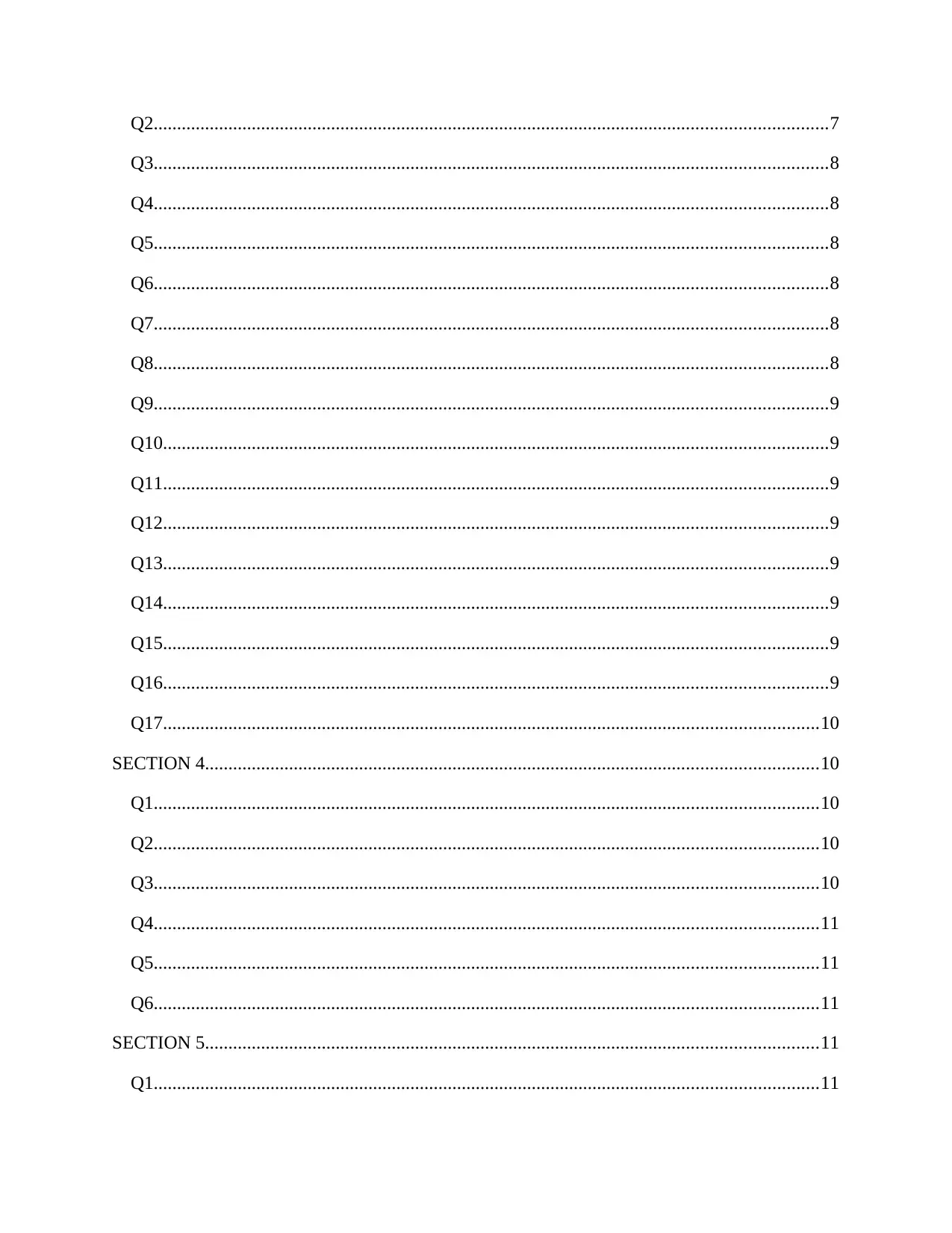
Q2................................................................................................................................................7
Q3................................................................................................................................................8
Q4................................................................................................................................................8
Q5................................................................................................................................................8
Q6................................................................................................................................................8
Q7................................................................................................................................................8
Q8................................................................................................................................................8
Q9................................................................................................................................................9
Q10..............................................................................................................................................9
Q11..............................................................................................................................................9
Q12..............................................................................................................................................9
Q13..............................................................................................................................................9
Q14..............................................................................................................................................9
Q15..............................................................................................................................................9
Q16..............................................................................................................................................9
Q17............................................................................................................................................10
SECTION 4...................................................................................................................................10
Q1..............................................................................................................................................10
Q2..............................................................................................................................................10
Q3..............................................................................................................................................10
Q4..............................................................................................................................................11
Q5..............................................................................................................................................11
Q6..............................................................................................................................................11
SECTION 5...................................................................................................................................11
Q1..............................................................................................................................................11
Q3................................................................................................................................................8
Q4................................................................................................................................................8
Q5................................................................................................................................................8
Q6................................................................................................................................................8
Q7................................................................................................................................................8
Q8................................................................................................................................................8
Q9................................................................................................................................................9
Q10..............................................................................................................................................9
Q11..............................................................................................................................................9
Q12..............................................................................................................................................9
Q13..............................................................................................................................................9
Q14..............................................................................................................................................9
Q15..............................................................................................................................................9
Q16..............................................................................................................................................9
Q17............................................................................................................................................10
SECTION 4...................................................................................................................................10
Q1..............................................................................................................................................10
Q2..............................................................................................................................................10
Q3..............................................................................................................................................10
Q4..............................................................................................................................................11
Q5..............................................................................................................................................11
Q6..............................................................................................................................................11
SECTION 5...................................................................................................................................11
Q1..............................................................................................................................................11
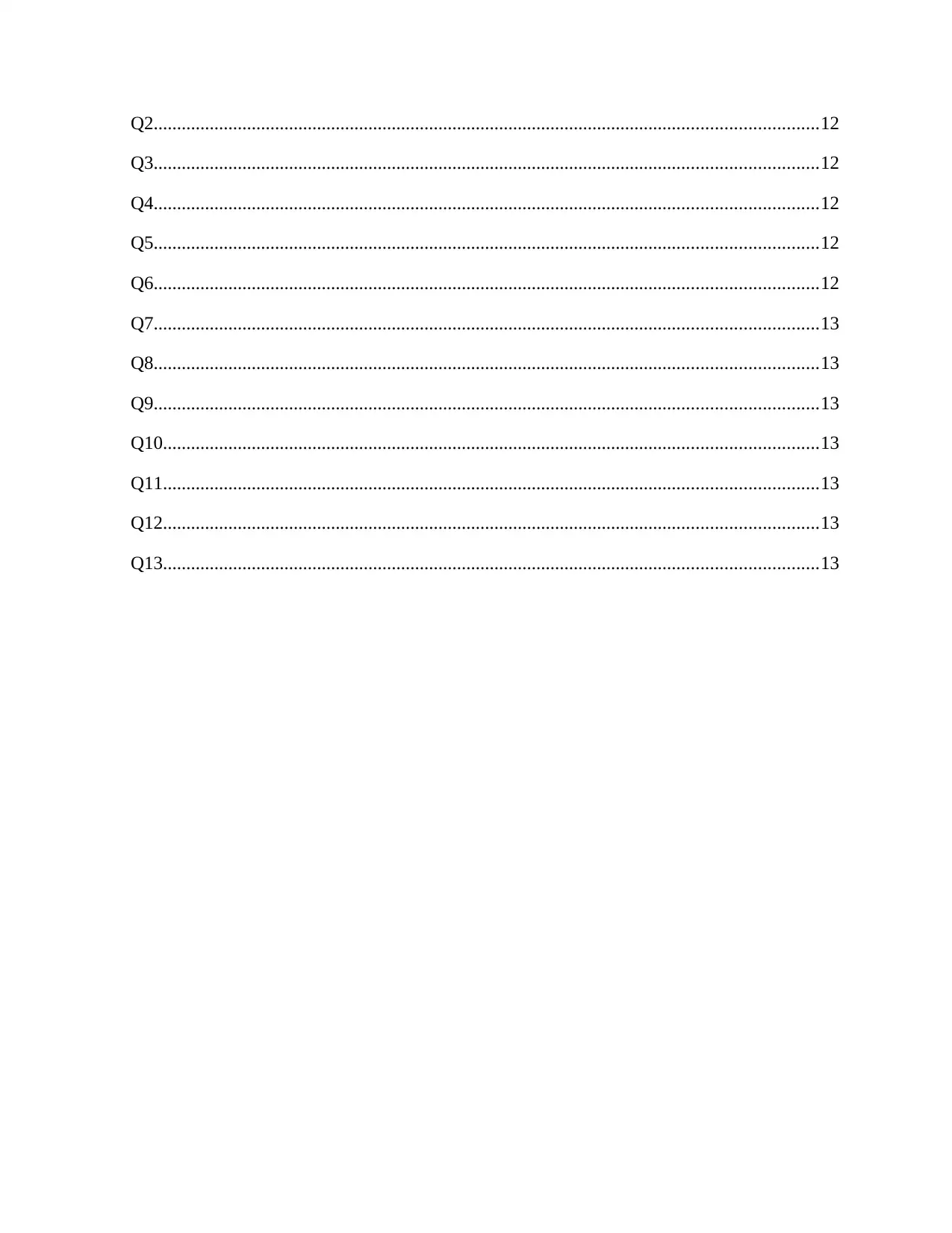
Q2..............................................................................................................................................12
Q3..............................................................................................................................................12
Q4..............................................................................................................................................12
Q5..............................................................................................................................................12
Q6..............................................................................................................................................12
Q7..............................................................................................................................................13
Q8..............................................................................................................................................13
Q9..............................................................................................................................................13
Q10............................................................................................................................................13
Q11............................................................................................................................................13
Q12............................................................................................................................................13
Q13............................................................................................................................................13
Q3..............................................................................................................................................12
Q4..............................................................................................................................................12
Q5..............................................................................................................................................12
Q6..............................................................................................................................................12
Q7..............................................................................................................................................13
Q8..............................................................................................................................................13
Q9..............................................................................................................................................13
Q10............................................................................................................................................13
Q11............................................................................................................................................13
Q12............................................................................................................................................13
Q13............................................................................................................................................13
Secure Best Marks with AI Grader
Need help grading? Try our AI Grader for instant feedback on your assignments.
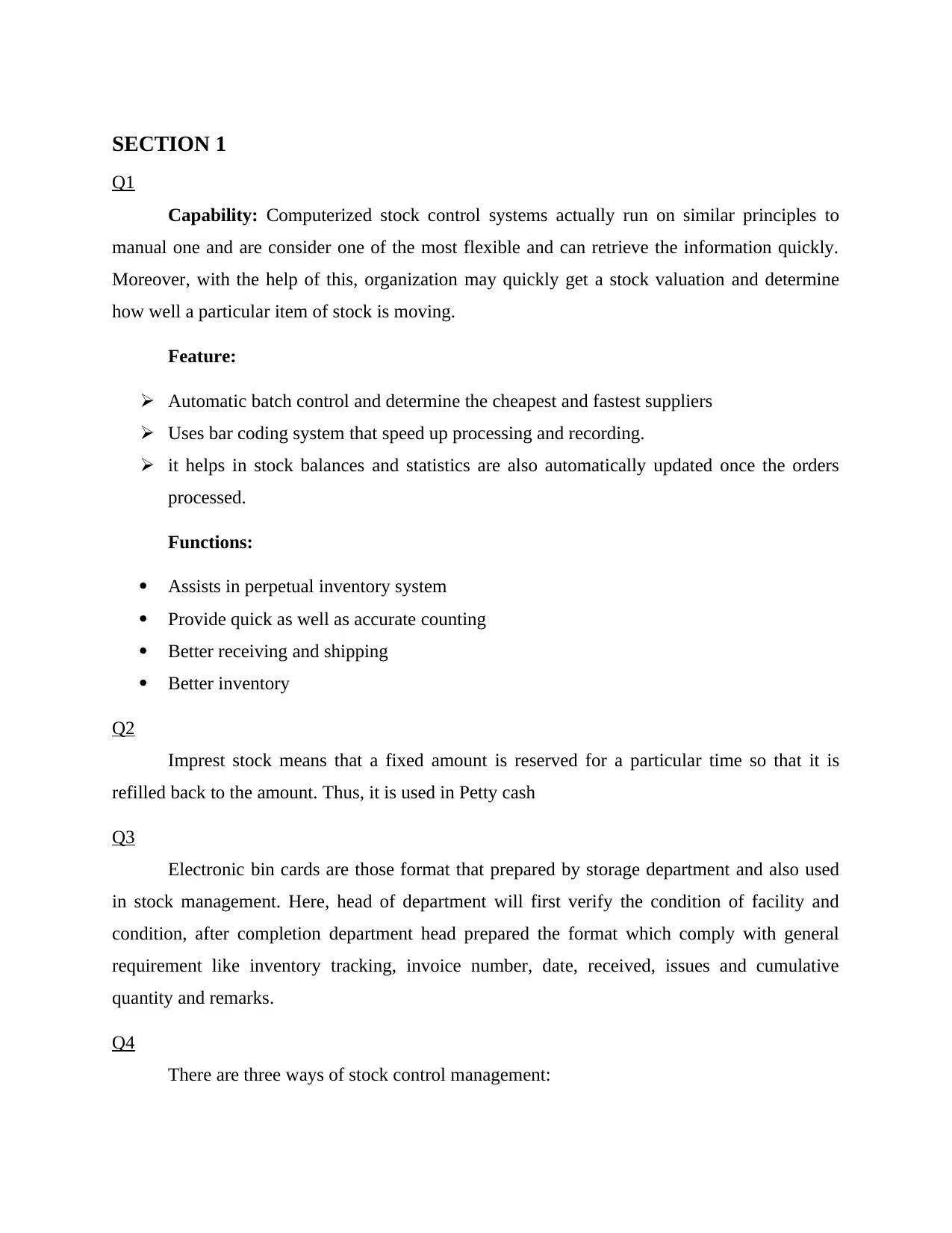
SECTION 1
Q1
Capability: Computerized stock control systems actually run on similar principles to
manual one and are consider one of the most flexible and can retrieve the information quickly.
Moreover, with the help of this, organization may quickly get a stock valuation and determine
how well a particular item of stock is moving.
Feature:
Automatic batch control and determine the cheapest and fastest suppliers
Uses bar coding system that speed up processing and recording.
it helps in stock balances and statistics are also automatically updated once the orders
processed.
Functions:
Assists in perpetual inventory system
Provide quick as well as accurate counting
Better receiving and shipping
Better inventory
Q2
Imprest stock means that a fixed amount is reserved for a particular time so that it is
refilled back to the amount. Thus, it is used in Petty cash
Q3
Electronic bin cards are those format that prepared by storage department and also used
in stock management. Here, head of department will first verify the condition of facility and
condition, after completion department head prepared the format which comply with general
requirement like inventory tracking, invoice number, date, received, issues and cumulative
quantity and remarks.
Q4
There are three ways of stock control management:
Q1
Capability: Computerized stock control systems actually run on similar principles to
manual one and are consider one of the most flexible and can retrieve the information quickly.
Moreover, with the help of this, organization may quickly get a stock valuation and determine
how well a particular item of stock is moving.
Feature:
Automatic batch control and determine the cheapest and fastest suppliers
Uses bar coding system that speed up processing and recording.
it helps in stock balances and statistics are also automatically updated once the orders
processed.
Functions:
Assists in perpetual inventory system
Provide quick as well as accurate counting
Better receiving and shipping
Better inventory
Q2
Imprest stock means that a fixed amount is reserved for a particular time so that it is
refilled back to the amount. Thus, it is used in Petty cash
Q3
Electronic bin cards are those format that prepared by storage department and also used
in stock management. Here, head of department will first verify the condition of facility and
condition, after completion department head prepared the format which comply with general
requirement like inventory tracking, invoice number, date, received, issues and cumulative
quantity and remarks.
Q4
There are three ways of stock control management:
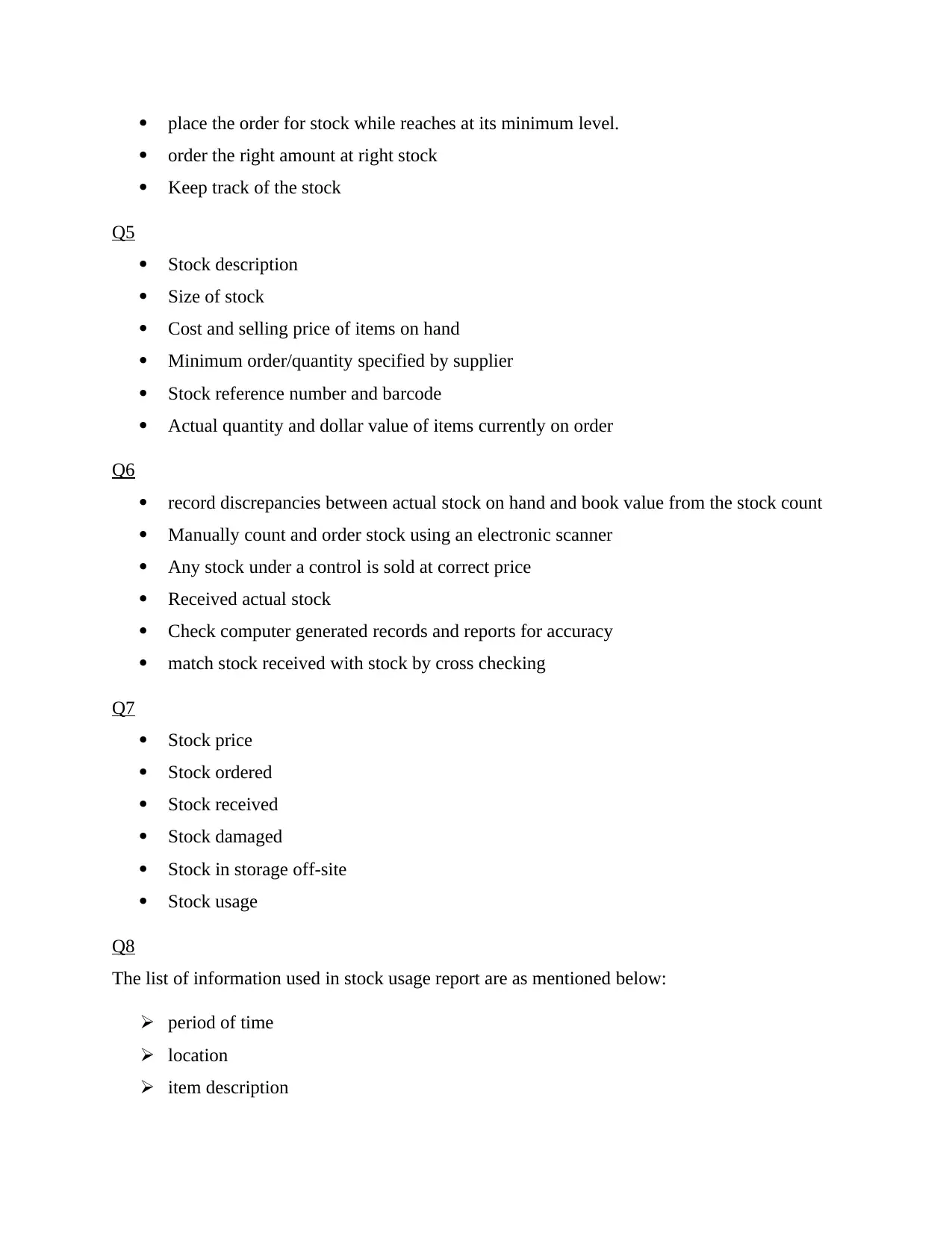
place the order for stock while reaches at its minimum level.
order the right amount at right stock
Keep track of the stock
Q5
Stock description
Size of stock
Cost and selling price of items on hand
Minimum order/quantity specified by supplier
Stock reference number and barcode
Actual quantity and dollar value of items currently on order
Q6
record discrepancies between actual stock on hand and book value from the stock count
Manually count and order stock using an electronic scanner
Any stock under a control is sold at correct price
Received actual stock
Check computer generated records and reports for accuracy
match stock received with stock by cross checking
Q7
Stock price
Stock ordered
Stock received
Stock damaged
Stock in storage off-site
Stock usage
Q8
The list of information used in stock usage report are as mentioned below:
period of time
location
item description
order the right amount at right stock
Keep track of the stock
Q5
Stock description
Size of stock
Cost and selling price of items on hand
Minimum order/quantity specified by supplier
Stock reference number and barcode
Actual quantity and dollar value of items currently on order
Q6
record discrepancies between actual stock on hand and book value from the stock count
Manually count and order stock using an electronic scanner
Any stock under a control is sold at correct price
Received actual stock
Check computer generated records and reports for accuracy
match stock received with stock by cross checking
Q7
Stock price
Stock ordered
Stock received
Stock damaged
Stock in storage off-site
Stock usage
Q8
The list of information used in stock usage report are as mentioned below:
period of time
location
item description
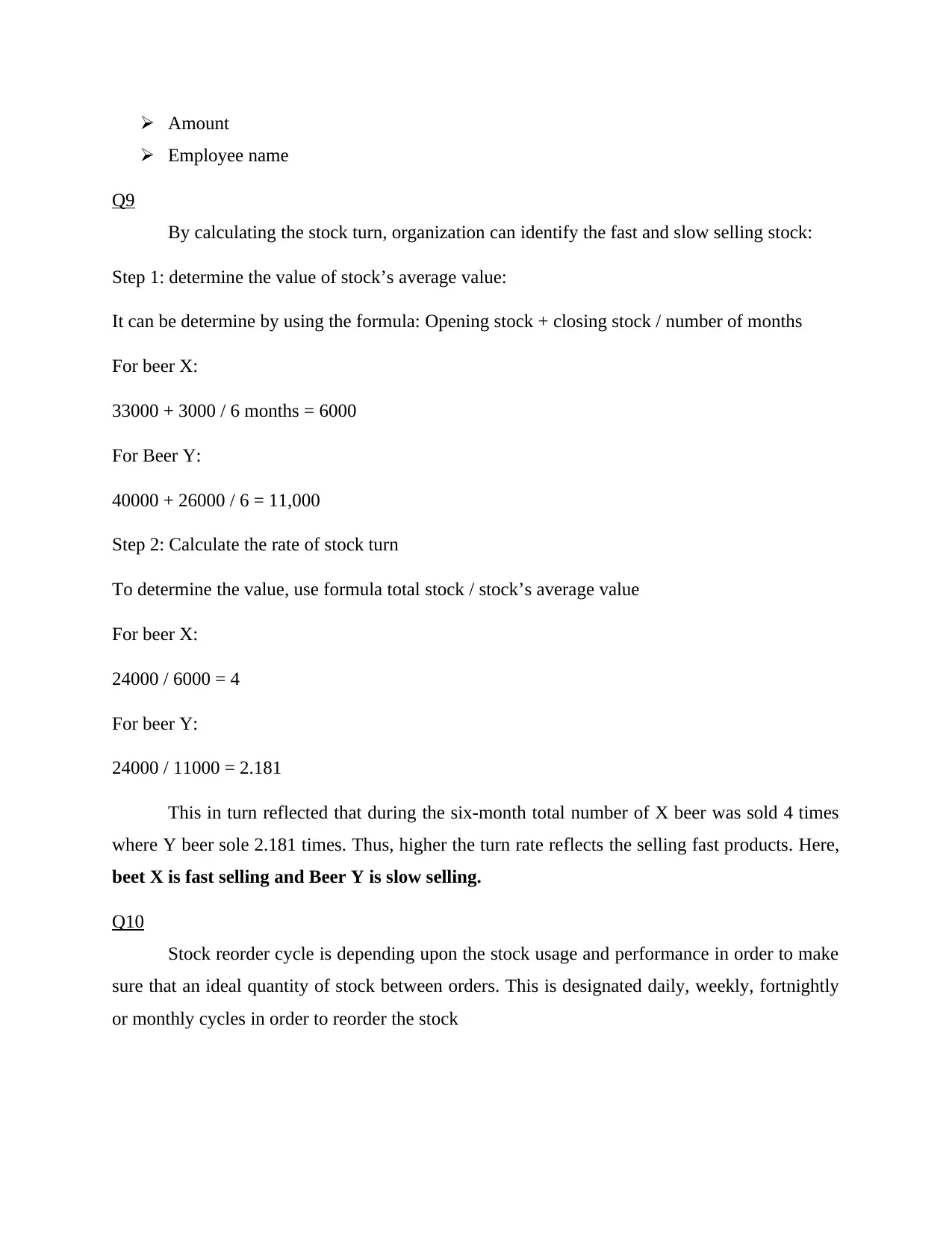
Amount
Employee name
Q9
By calculating the stock turn, organization can identify the fast and slow selling stock:
Step 1: determine the value of stock’s average value:
It can be determine by using the formula: Opening stock + closing stock / number of months
For beer X:
33000 + 3000 / 6 months = 6000
For Beer Y:
40000 + 26000 / 6 = 11,000
Step 2: Calculate the rate of stock turn
To determine the value, use formula total stock / stock’s average value
For beer X:
24000 / 6000 = 4
For beer Y:
24000 / 11000 = 2.181
This in turn reflected that during the six-month total number of X beer was sold 4 times
where Y beer sole 2.181 times. Thus, higher the turn rate reflects the selling fast products. Here,
beet X is fast selling and Beer Y is slow selling.
Q10
Stock reorder cycle is depending upon the stock usage and performance in order to make
sure that an ideal quantity of stock between orders. This is designated daily, weekly, fortnightly
or monthly cycles in order to reorder the stock
Employee name
Q9
By calculating the stock turn, organization can identify the fast and slow selling stock:
Step 1: determine the value of stock’s average value:
It can be determine by using the formula: Opening stock + closing stock / number of months
For beer X:
33000 + 3000 / 6 months = 6000
For Beer Y:
40000 + 26000 / 6 = 11,000
Step 2: Calculate the rate of stock turn
To determine the value, use formula total stock / stock’s average value
For beer X:
24000 / 6000 = 4
For beer Y:
24000 / 11000 = 2.181
This in turn reflected that during the six-month total number of X beer was sold 4 times
where Y beer sole 2.181 times. Thus, higher the turn rate reflects the selling fast products. Here,
beet X is fast selling and Beer Y is slow selling.
Q10
Stock reorder cycle is depending upon the stock usage and performance in order to make
sure that an ideal quantity of stock between orders. This is designated daily, weekly, fortnightly
or monthly cycles in order to reorder the stock
Paraphrase This Document
Need a fresh take? Get an instant paraphrase of this document with our AI Paraphraser
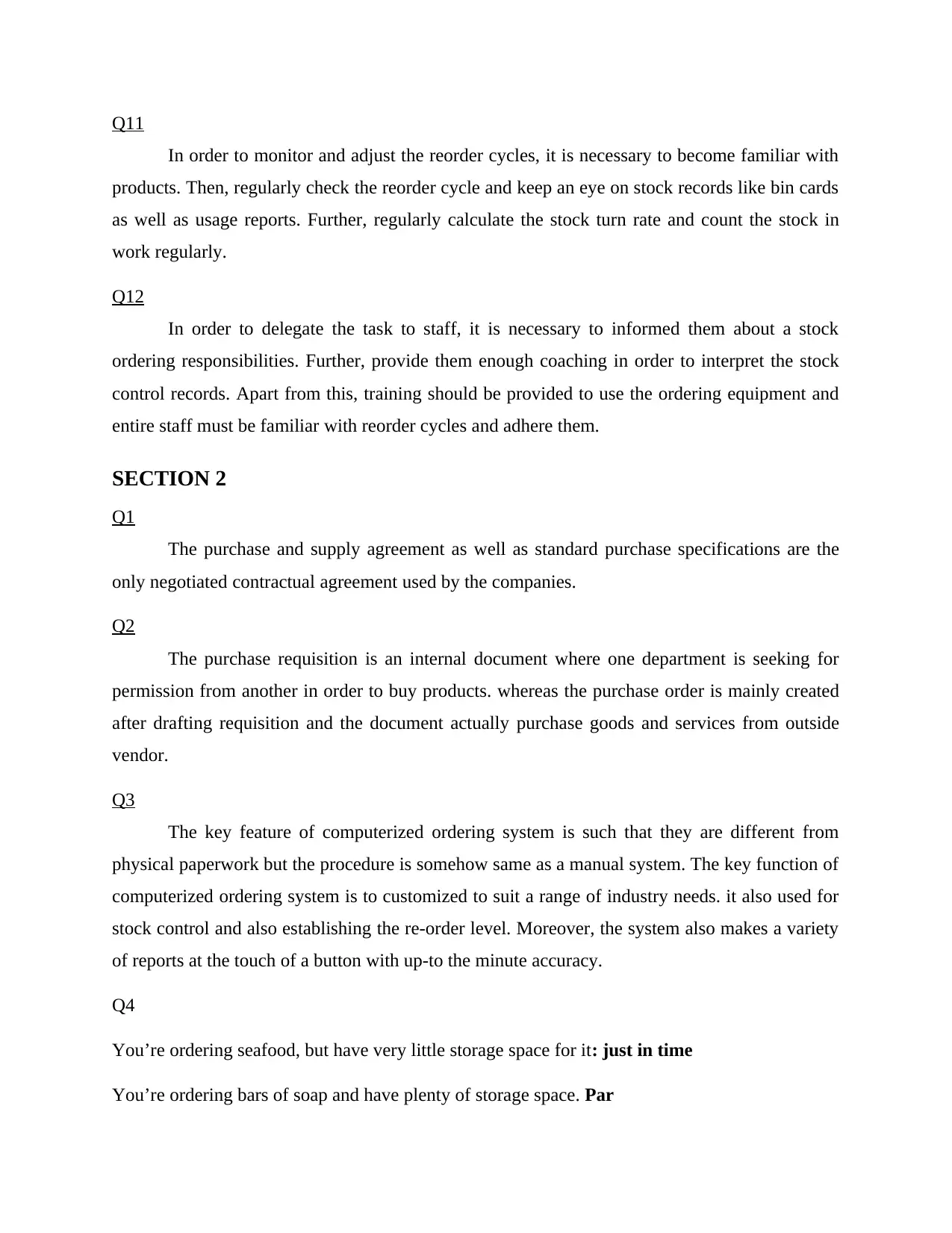
Q11
In order to monitor and adjust the reorder cycles, it is necessary to become familiar with
products. Then, regularly check the reorder cycle and keep an eye on stock records like bin cards
as well as usage reports. Further, regularly calculate the stock turn rate and count the stock in
work regularly.
Q12
In order to delegate the task to staff, it is necessary to informed them about a stock
ordering responsibilities. Further, provide them enough coaching in order to interpret the stock
control records. Apart from this, training should be provided to use the ordering equipment and
entire staff must be familiar with reorder cycles and adhere them.
SECTION 2
Q1
The purchase and supply agreement as well as standard purchase specifications are the
only negotiated contractual agreement used by the companies.
Q2
The purchase requisition is an internal document where one department is seeking for
permission from another in order to buy products. whereas the purchase order is mainly created
after drafting requisition and the document actually purchase goods and services from outside
vendor.
Q3
The key feature of computerized ordering system is such that they are different from
physical paperwork but the procedure is somehow same as a manual system. The key function of
computerized ordering system is to customized to suit a range of industry needs. it also used for
stock control and also establishing the re-order level. Moreover, the system also makes a variety
of reports at the touch of a button with up-to the minute accuracy.
Q4
You’re ordering seafood, but have very little storage space for it: just in time
You’re ordering bars of soap and have plenty of storage space. Par
In order to monitor and adjust the reorder cycles, it is necessary to become familiar with
products. Then, regularly check the reorder cycle and keep an eye on stock records like bin cards
as well as usage reports. Further, regularly calculate the stock turn rate and count the stock in
work regularly.
Q12
In order to delegate the task to staff, it is necessary to informed them about a stock
ordering responsibilities. Further, provide them enough coaching in order to interpret the stock
control records. Apart from this, training should be provided to use the ordering equipment and
entire staff must be familiar with reorder cycles and adhere them.
SECTION 2
Q1
The purchase and supply agreement as well as standard purchase specifications are the
only negotiated contractual agreement used by the companies.
Q2
The purchase requisition is an internal document where one department is seeking for
permission from another in order to buy products. whereas the purchase order is mainly created
after drafting requisition and the document actually purchase goods and services from outside
vendor.
Q3
The key feature of computerized ordering system is such that they are different from
physical paperwork but the procedure is somehow same as a manual system. The key function of
computerized ordering system is to customized to suit a range of industry needs. it also used for
stock control and also establishing the re-order level. Moreover, the system also makes a variety
of reports at the touch of a button with up-to the minute accuracy.
Q4
You’re ordering seafood, but have very little storage space for it: just in time
You’re ordering bars of soap and have plenty of storage space. Par
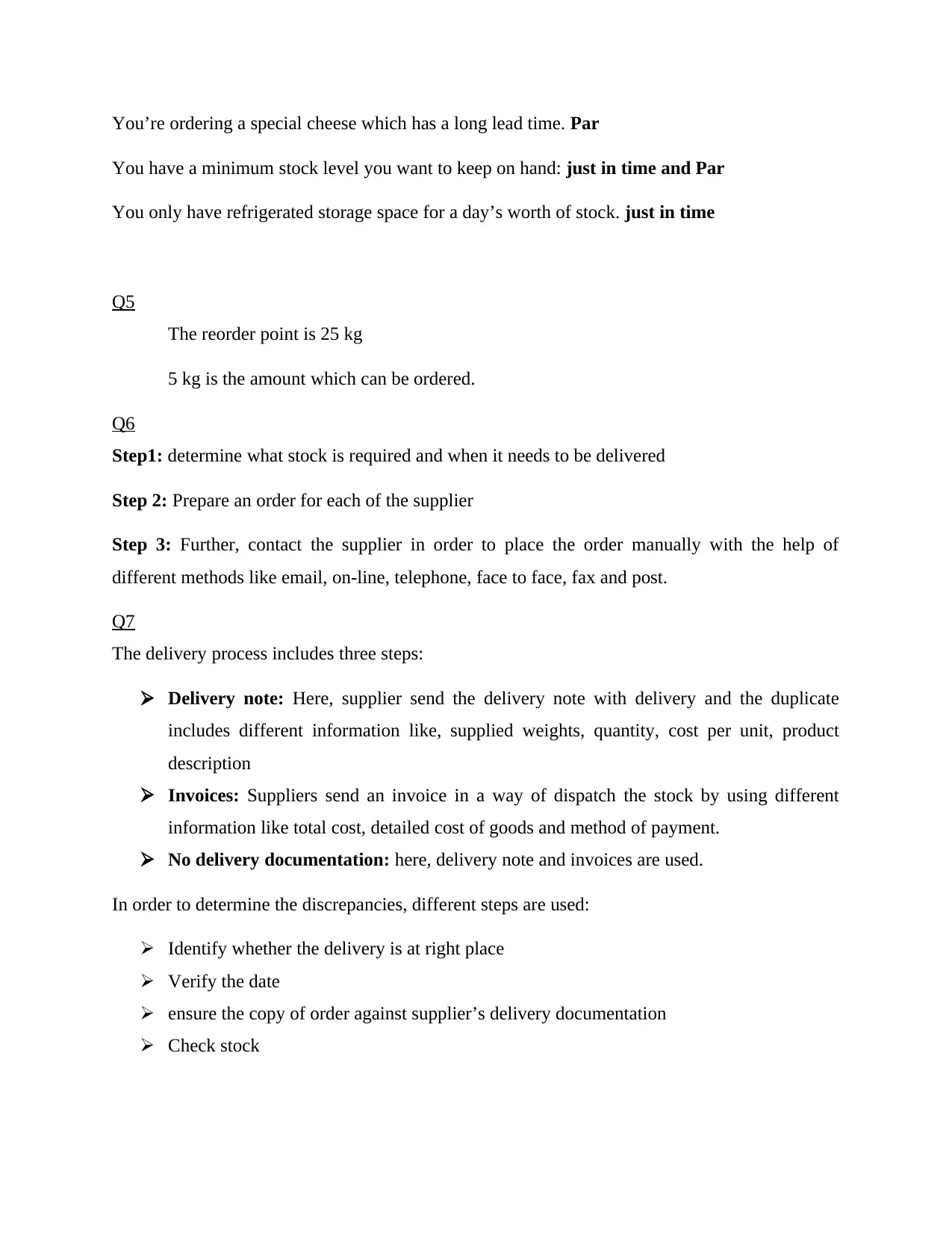
You’re ordering a special cheese which has a long lead time. Par
You have a minimum stock level you want to keep on hand: just in time and Par
You only have refrigerated storage space for a day’s worth of stock. just in time
Q5
The reorder point is 25 kg
5 kg is the amount which can be ordered.
Q6
Step1: determine what stock is required and when it needs to be delivered
Step 2: Prepare an order for each of the supplier
Step 3: Further, contact the supplier in order to place the order manually with the help of
different methods like email, on-line, telephone, face to face, fax and post.
Q7
The delivery process includes three steps:
Delivery note: Here, supplier send the delivery note with delivery and the duplicate
includes different information like, supplied weights, quantity, cost per unit, product
description
Invoices: Suppliers send an invoice in a way of dispatch the stock by using different
information like total cost, detailed cost of goods and method of payment.
No delivery documentation: here, delivery note and invoices are used.
In order to determine the discrepancies, different steps are used:
Identify whether the delivery is at right place
Verify the date
ensure the copy of order against supplier’s delivery documentation
Check stock
You have a minimum stock level you want to keep on hand: just in time and Par
You only have refrigerated storage space for a day’s worth of stock. just in time
Q5
The reorder point is 25 kg
5 kg is the amount which can be ordered.
Q6
Step1: determine what stock is required and when it needs to be delivered
Step 2: Prepare an order for each of the supplier
Step 3: Further, contact the supplier in order to place the order manually with the help of
different methods like email, on-line, telephone, face to face, fax and post.
Q7
The delivery process includes three steps:
Delivery note: Here, supplier send the delivery note with delivery and the duplicate
includes different information like, supplied weights, quantity, cost per unit, product
description
Invoices: Suppliers send an invoice in a way of dispatch the stock by using different
information like total cost, detailed cost of goods and method of payment.
No delivery documentation: here, delivery note and invoices are used.
In order to determine the discrepancies, different steps are used:
Identify whether the delivery is at right place
Verify the date
ensure the copy of order against supplier’s delivery documentation
Check stock

Q8
In order to record any stock delivered or discrepancies, different steps are used which are
as mentioned below:
Tick the items which are accepted during delivery documentation.
Cross the missing items off the delivery documentation
cross the items which are rejected
immediately note the stock related discrepancies
Q9
There is a need to keep monitoring the areas such as delivery and dispatch areas, point of
sale transactions, processing return, credits, refunds and exchanges, kitchen storage areas.
SECTION 3
Q1
There are eight security systems which are used by the company such as:
Alarm systems
Security tags
Surveillance
Locked and secured stock
Barcodes
CCTV
Dummy tags
Reusable EAS tags
There are many equipment used by the organization in order to protect the stock losses such
as lock and key, CCTV, mirrors, alarms etc.
Q2
In order to reduce the EAS, the two procedure are used by the company are as mentioned
below:
Test the EAS systems regularly in order to instruct prior to open the retail outlet.
Checking the deactivation systems in order to remove the failure.
In order to record any stock delivered or discrepancies, different steps are used which are
as mentioned below:
Tick the items which are accepted during delivery documentation.
Cross the missing items off the delivery documentation
cross the items which are rejected
immediately note the stock related discrepancies
Q9
There is a need to keep monitoring the areas such as delivery and dispatch areas, point of
sale transactions, processing return, credits, refunds and exchanges, kitchen storage areas.
SECTION 3
Q1
There are eight security systems which are used by the company such as:
Alarm systems
Security tags
Surveillance
Locked and secured stock
Barcodes
CCTV
Dummy tags
Reusable EAS tags
There are many equipment used by the organization in order to protect the stock losses such
as lock and key, CCTV, mirrors, alarms etc.
Q2
In order to reduce the EAS, the two procedure are used by the company are as mentioned
below:
Test the EAS systems regularly in order to instruct prior to open the retail outlet.
Checking the deactivation systems in order to remove the failure.
Secure Best Marks with AI Grader
Need help grading? Try our AI Grader for instant feedback on your assignments.
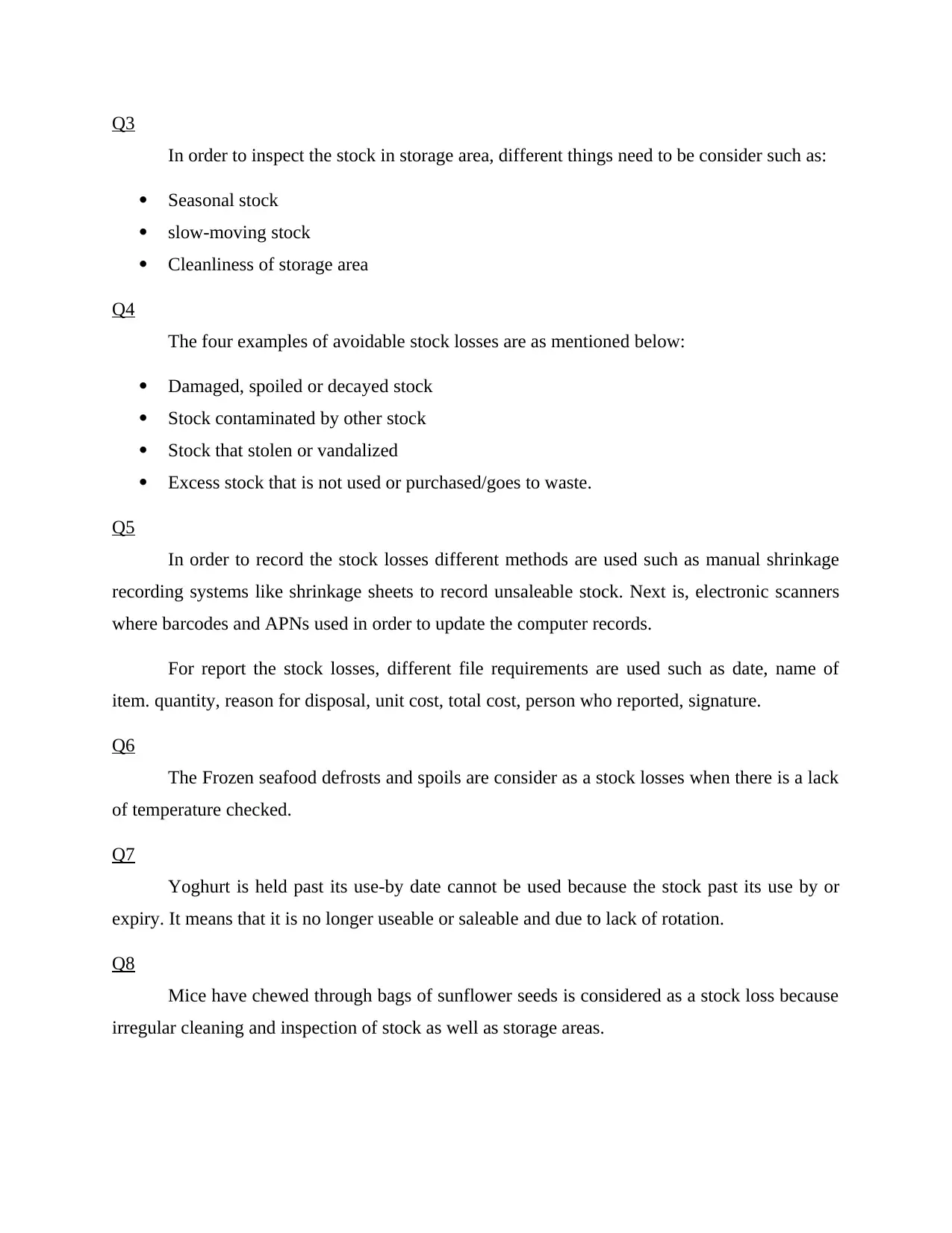
Q3
In order to inspect the stock in storage area, different things need to be consider such as:
Seasonal stock
slow-moving stock
Cleanliness of storage area
Q4
The four examples of avoidable stock losses are as mentioned below:
Damaged, spoiled or decayed stock
Stock contaminated by other stock
Stock that stolen or vandalized
Excess stock that is not used or purchased/goes to waste.
Q5
In order to record the stock losses different methods are used such as manual shrinkage
recording systems like shrinkage sheets to record unsaleable stock. Next is, electronic scanners
where barcodes and APNs used in order to update the computer records.
For report the stock losses, different file requirements are used such as date, name of
item. quantity, reason for disposal, unit cost, total cost, person who reported, signature.
Q6
The Frozen seafood defrosts and spoils are consider as a stock losses when there is a lack
of temperature checked.
Q7
Yoghurt is held past its use-by date cannot be used because the stock past its use by or
expiry. It means that it is no longer useable or saleable and due to lack of rotation.
Q8
Mice have chewed through bags of sunflower seeds is considered as a stock loss because
irregular cleaning and inspection of stock as well as storage areas.
In order to inspect the stock in storage area, different things need to be consider such as:
Seasonal stock
slow-moving stock
Cleanliness of storage area
Q4
The four examples of avoidable stock losses are as mentioned below:
Damaged, spoiled or decayed stock
Stock contaminated by other stock
Stock that stolen or vandalized
Excess stock that is not used or purchased/goes to waste.
Q5
In order to record the stock losses different methods are used such as manual shrinkage
recording systems like shrinkage sheets to record unsaleable stock. Next is, electronic scanners
where barcodes and APNs used in order to update the computer records.
For report the stock losses, different file requirements are used such as date, name of
item. quantity, reason for disposal, unit cost, total cost, person who reported, signature.
Q6
The Frozen seafood defrosts and spoils are consider as a stock losses when there is a lack
of temperature checked.
Q7
Yoghurt is held past its use-by date cannot be used because the stock past its use by or
expiry. It means that it is no longer useable or saleable and due to lack of rotation.
Q8
Mice have chewed through bags of sunflower seeds is considered as a stock loss because
irregular cleaning and inspection of stock as well as storage areas.
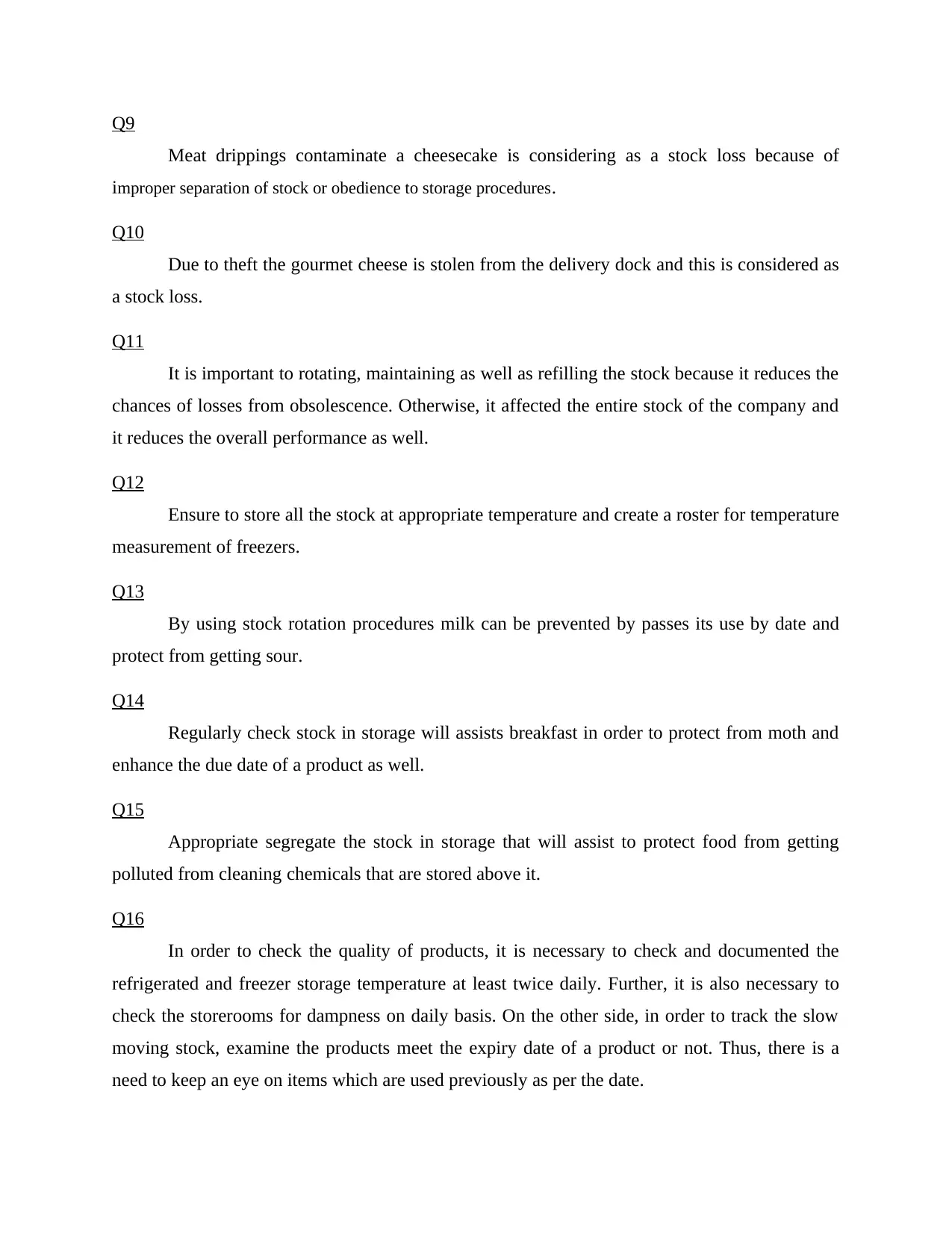
Q9
Meat drippings contaminate a cheesecake is considering as a stock loss because of
improper separation of stock or obedience to storage procedures.
Q10
Due to theft the gourmet cheese is stolen from the delivery dock and this is considered as
a stock loss.
Q11
It is important to rotating, maintaining as well as refilling the stock because it reduces the
chances of losses from obsolescence. Otherwise, it affected the entire stock of the company and
it reduces the overall performance as well.
Q12
Ensure to store all the stock at appropriate temperature and create a roster for temperature
measurement of freezers.
Q13
By using stock rotation procedures milk can be prevented by passes its use by date and
protect from getting sour.
Q14
Regularly check stock in storage will assists breakfast in order to protect from moth and
enhance the due date of a product as well.
Q15
Appropriate segregate the stock in storage that will assist to protect food from getting
polluted from cleaning chemicals that are stored above it.
Q16
In order to check the quality of products, it is necessary to check and documented the
refrigerated and freezer storage temperature at least twice daily. Further, it is also necessary to
check the storerooms for dampness on daily basis. On the other side, in order to track the slow
moving stock, examine the products meet the expiry date of a product or not. Thus, there is a
need to keep an eye on items which are used previously as per the date.
Meat drippings contaminate a cheesecake is considering as a stock loss because of
improper separation of stock or obedience to storage procedures.
Q10
Due to theft the gourmet cheese is stolen from the delivery dock and this is considered as
a stock loss.
Q11
It is important to rotating, maintaining as well as refilling the stock because it reduces the
chances of losses from obsolescence. Otherwise, it affected the entire stock of the company and
it reduces the overall performance as well.
Q12
Ensure to store all the stock at appropriate temperature and create a roster for temperature
measurement of freezers.
Q13
By using stock rotation procedures milk can be prevented by passes its use by date and
protect from getting sour.
Q14
Regularly check stock in storage will assists breakfast in order to protect from moth and
enhance the due date of a product as well.
Q15
Appropriate segregate the stock in storage that will assist to protect food from getting
polluted from cleaning chemicals that are stored above it.
Q16
In order to check the quality of products, it is necessary to check and documented the
refrigerated and freezer storage temperature at least twice daily. Further, it is also necessary to
check the storerooms for dampness on daily basis. On the other side, in order to track the slow
moving stock, examine the products meet the expiry date of a product or not. Thus, there is a
need to keep an eye on items which are used previously as per the date.
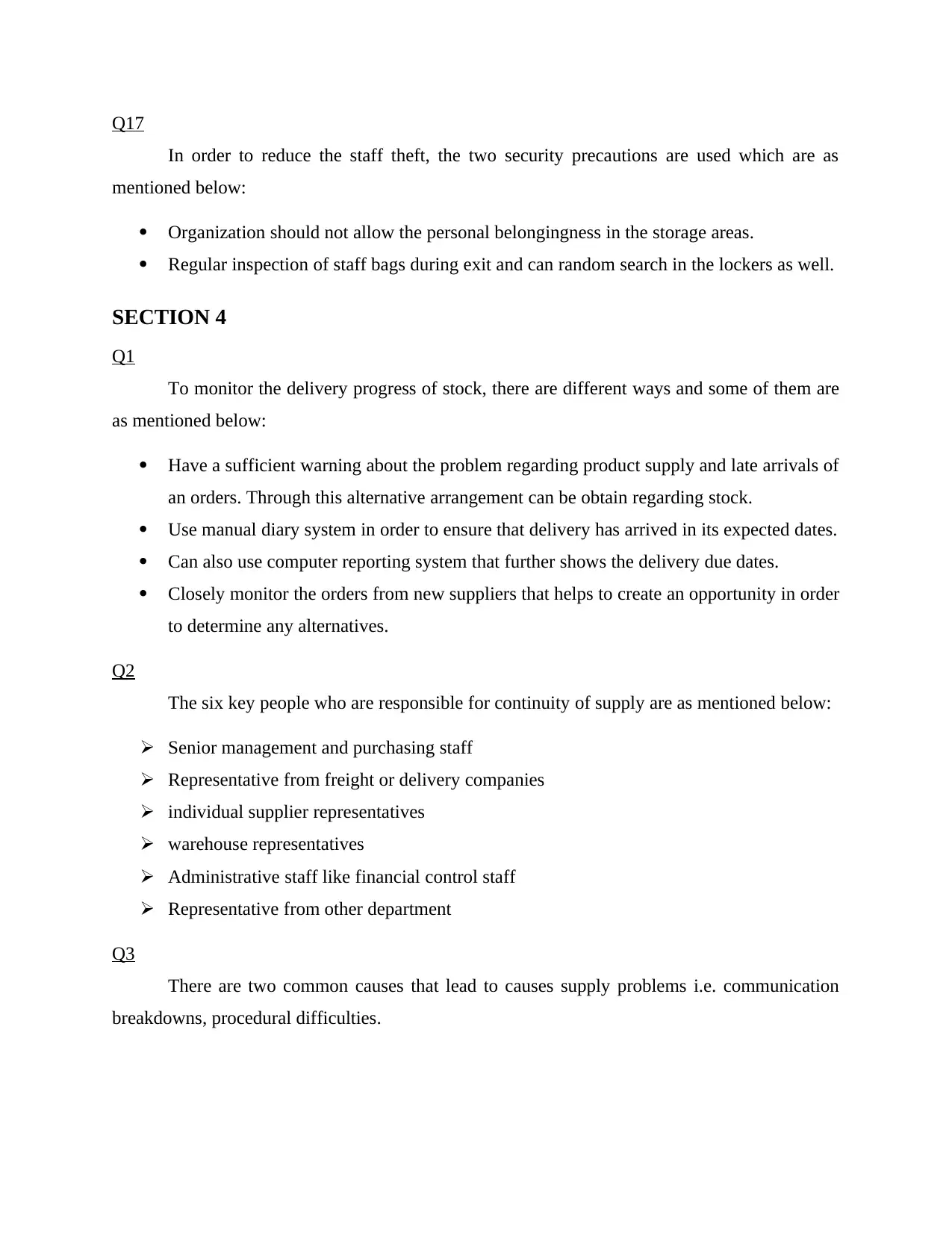
Q17
In order to reduce the staff theft, the two security precautions are used which are as
mentioned below:
Organization should not allow the personal belongingness in the storage areas.
Regular inspection of staff bags during exit and can random search in the lockers as well.
SECTION 4
Q1
To monitor the delivery progress of stock, there are different ways and some of them are
as mentioned below:
Have a sufficient warning about the problem regarding product supply and late arrivals of
an orders. Through this alternative arrangement can be obtain regarding stock.
Use manual diary system in order to ensure that delivery has arrived in its expected dates.
Can also use computer reporting system that further shows the delivery due dates.
Closely monitor the orders from new suppliers that helps to create an opportunity in order
to determine any alternatives.
Q2
The six key people who are responsible for continuity of supply are as mentioned below:
Senior management and purchasing staff
Representative from freight or delivery companies
individual supplier representatives
warehouse representatives
Administrative staff like financial control staff
Representative from other department
Q3
There are two common causes that lead to causes supply problems i.e. communication
breakdowns, procedural difficulties.
In order to reduce the staff theft, the two security precautions are used which are as
mentioned below:
Organization should not allow the personal belongingness in the storage areas.
Regular inspection of staff bags during exit and can random search in the lockers as well.
SECTION 4
Q1
To monitor the delivery progress of stock, there are different ways and some of them are
as mentioned below:
Have a sufficient warning about the problem regarding product supply and late arrivals of
an orders. Through this alternative arrangement can be obtain regarding stock.
Use manual diary system in order to ensure that delivery has arrived in its expected dates.
Can also use computer reporting system that further shows the delivery due dates.
Closely monitor the orders from new suppliers that helps to create an opportunity in order
to determine any alternatives.
Q2
The six key people who are responsible for continuity of supply are as mentioned below:
Senior management and purchasing staff
Representative from freight or delivery companies
individual supplier representatives
warehouse representatives
Administrative staff like financial control staff
Representative from other department
Q3
There are two common causes that lead to causes supply problems i.e. communication
breakdowns, procedural difficulties.
Paraphrase This Document
Need a fresh take? Get an instant paraphrase of this document with our AI Paraphraser
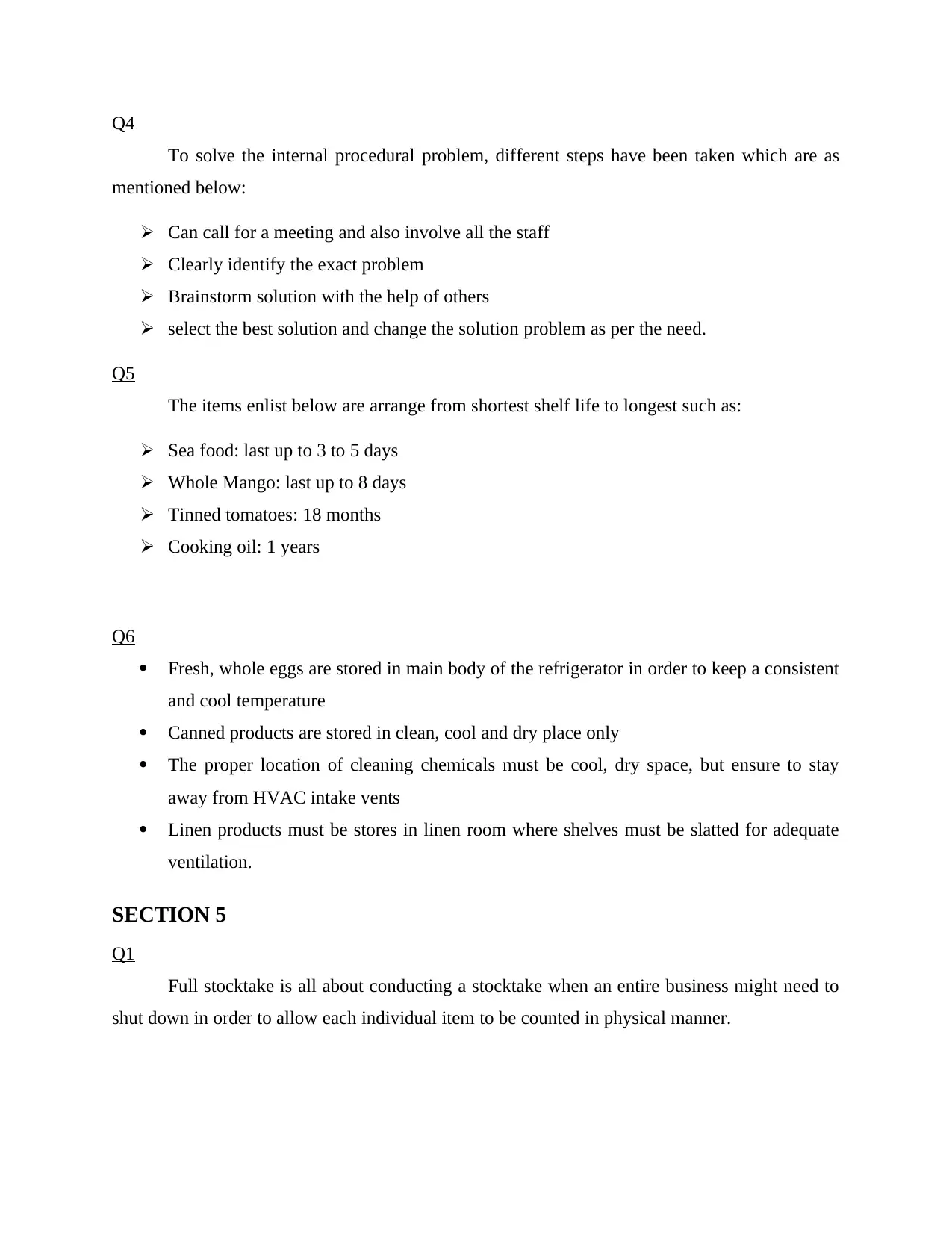
Q4
To solve the internal procedural problem, different steps have been taken which are as
mentioned below:
Can call for a meeting and also involve all the staff
Clearly identify the exact problem
Brainstorm solution with the help of others
select the best solution and change the solution problem as per the need.
Q5
The items enlist below are arrange from shortest shelf life to longest such as:
Sea food: last up to 3 to 5 days
Whole Mango: last up to 8 days
Tinned tomatoes: 18 months
Cooking oil: 1 years
Q6
Fresh, whole eggs are stored in main body of the refrigerator in order to keep a consistent
and cool temperature
Canned products are stored in clean, cool and dry place only
The proper location of cleaning chemicals must be cool, dry space, but ensure to stay
away from HVAC intake vents
Linen products must be stores in linen room where shelves must be slatted for adequate
ventilation.
SECTION 5
Q1
Full stocktake is all about conducting a stocktake when an entire business might need to
shut down in order to allow each individual item to be counted in physical manner.
To solve the internal procedural problem, different steps have been taken which are as
mentioned below:
Can call for a meeting and also involve all the staff
Clearly identify the exact problem
Brainstorm solution with the help of others
select the best solution and change the solution problem as per the need.
Q5
The items enlist below are arrange from shortest shelf life to longest such as:
Sea food: last up to 3 to 5 days
Whole Mango: last up to 8 days
Tinned tomatoes: 18 months
Cooking oil: 1 years
Q6
Fresh, whole eggs are stored in main body of the refrigerator in order to keep a consistent
and cool temperature
Canned products are stored in clean, cool and dry place only
The proper location of cleaning chemicals must be cool, dry space, but ensure to stay
away from HVAC intake vents
Linen products must be stores in linen room where shelves must be slatted for adequate
ventilation.
SECTION 5
Q1
Full stocktake is all about conducting a stocktake when an entire business might need to
shut down in order to allow each individual item to be counted in physical manner.
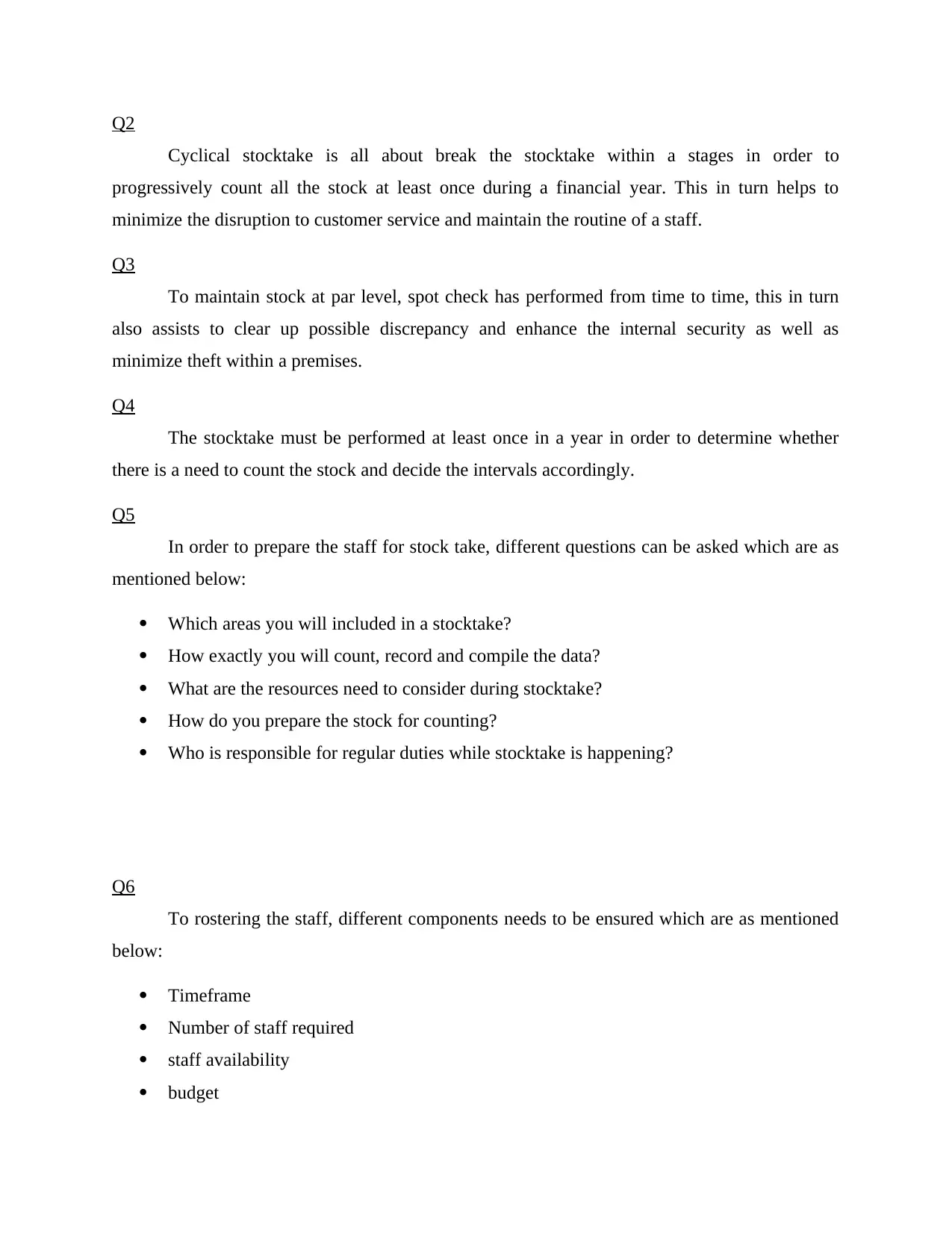
Q2
Cyclical stocktake is all about break the stocktake within a stages in order to
progressively count all the stock at least once during a financial year. This in turn helps to
minimize the disruption to customer service and maintain the routine of a staff.
Q3
To maintain stock at par level, spot check has performed from time to time, this in turn
also assists to clear up possible discrepancy and enhance the internal security as well as
minimize theft within a premises.
Q4
The stocktake must be performed at least once in a year in order to determine whether
there is a need to count the stock and decide the intervals accordingly.
Q5
In order to prepare the staff for stock take, different questions can be asked which are as
mentioned below:
Which areas you will included in a stocktake?
How exactly you will count, record and compile the data?
What are the resources need to consider during stocktake?
How do you prepare the stock for counting?
Who is responsible for regular duties while stocktake is happening?
Q6
To rostering the staff, different components needs to be ensured which are as mentioned
below:
Timeframe
Number of staff required
staff availability
budget
Cyclical stocktake is all about break the stocktake within a stages in order to
progressively count all the stock at least once during a financial year. This in turn helps to
minimize the disruption to customer service and maintain the routine of a staff.
Q3
To maintain stock at par level, spot check has performed from time to time, this in turn
also assists to clear up possible discrepancy and enhance the internal security as well as
minimize theft within a premises.
Q4
The stocktake must be performed at least once in a year in order to determine whether
there is a need to count the stock and decide the intervals accordingly.
Q5
In order to prepare the staff for stock take, different questions can be asked which are as
mentioned below:
Which areas you will included in a stocktake?
How exactly you will count, record and compile the data?
What are the resources need to consider during stocktake?
How do you prepare the stock for counting?
Who is responsible for regular duties while stocktake is happening?
Q6
To rostering the staff, different components needs to be ensured which are as mentioned
below:
Timeframe
Number of staff required
staff availability
budget
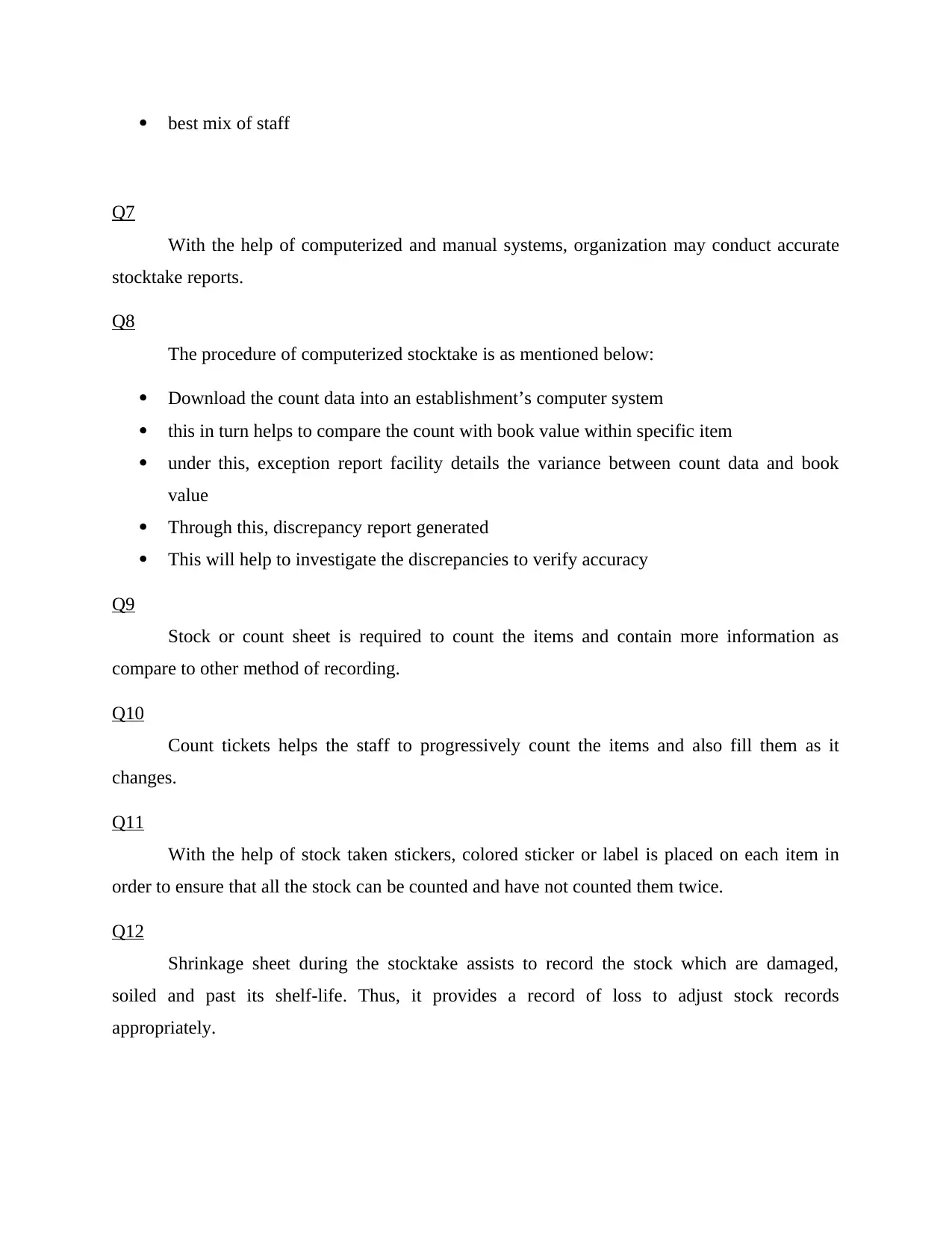
best mix of staff
Q7
With the help of computerized and manual systems, organization may conduct accurate
stocktake reports.
Q8
The procedure of computerized stocktake is as mentioned below:
Download the count data into an establishment’s computer system
this in turn helps to compare the count with book value within specific item
under this, exception report facility details the variance between count data and book
value
Through this, discrepancy report generated
This will help to investigate the discrepancies to verify accuracy
Q9
Stock or count sheet is required to count the items and contain more information as
compare to other method of recording.
Q10
Count tickets helps the staff to progressively count the items and also fill them as it
changes.
Q11
With the help of stock taken stickers, colored sticker or label is placed on each item in
order to ensure that all the stock can be counted and have not counted them twice.
Q12
Shrinkage sheet during the stocktake assists to record the stock which are damaged,
soiled and past its shelf-life. Thus, it provides a record of loss to adjust stock records
appropriately.
Q7
With the help of computerized and manual systems, organization may conduct accurate
stocktake reports.
Q8
The procedure of computerized stocktake is as mentioned below:
Download the count data into an establishment’s computer system
this in turn helps to compare the count with book value within specific item
under this, exception report facility details the variance between count data and book
value
Through this, discrepancy report generated
This will help to investigate the discrepancies to verify accuracy
Q9
Stock or count sheet is required to count the items and contain more information as
compare to other method of recording.
Q10
Count tickets helps the staff to progressively count the items and also fill them as it
changes.
Q11
With the help of stock taken stickers, colored sticker or label is placed on each item in
order to ensure that all the stock can be counted and have not counted them twice.
Q12
Shrinkage sheet during the stocktake assists to record the stock which are damaged,
soiled and past its shelf-life. Thus, it provides a record of loss to adjust stock records
appropriately.
Secure Best Marks with AI Grader
Need help grading? Try our AI Grader for instant feedback on your assignments.
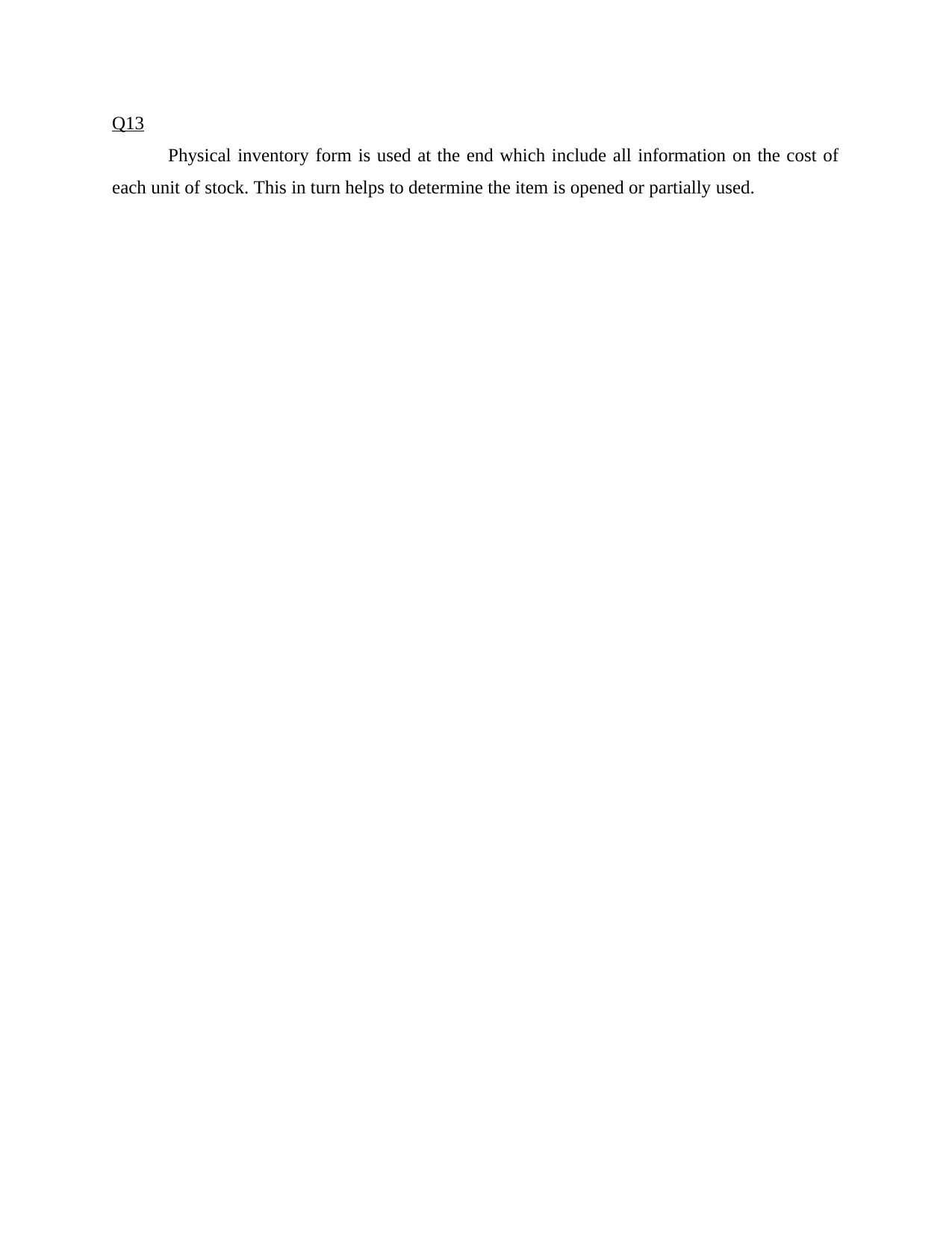
Q13
Physical inventory form is used at the end which include all information on the cost of
each unit of stock. This in turn helps to determine the item is opened or partially used.
Physical inventory form is used at the end which include all information on the cost of
each unit of stock. This in turn helps to determine the item is opened or partially used.
1 out of 17
Related Documents
Your All-in-One AI-Powered Toolkit for Academic Success.
+13062052269
info@desklib.com
Available 24*7 on WhatsApp / Email
![[object Object]](/_next/static/media/star-bottom.7253800d.svg)
Unlock your academic potential
© 2024 | Zucol Services PVT LTD | All rights reserved.





